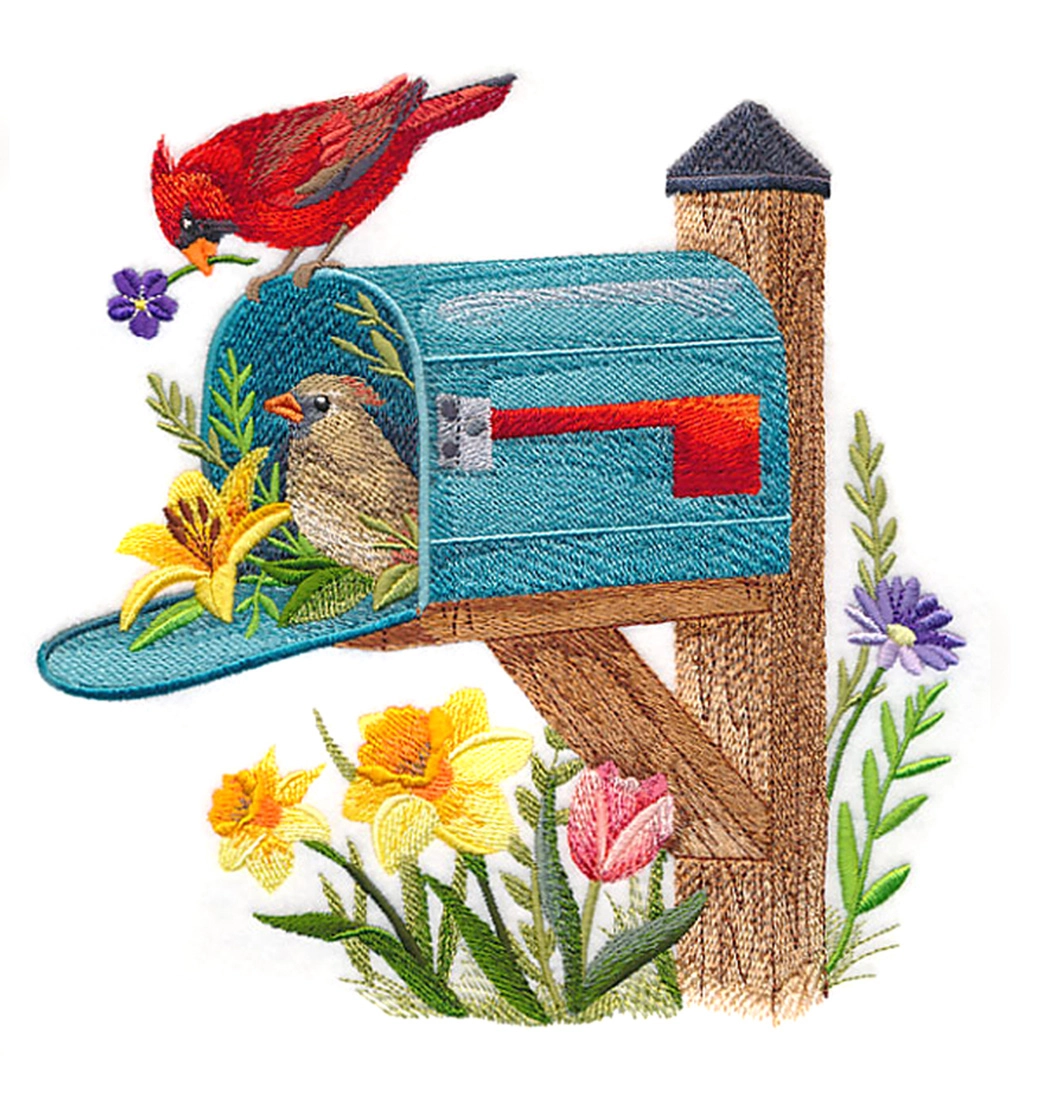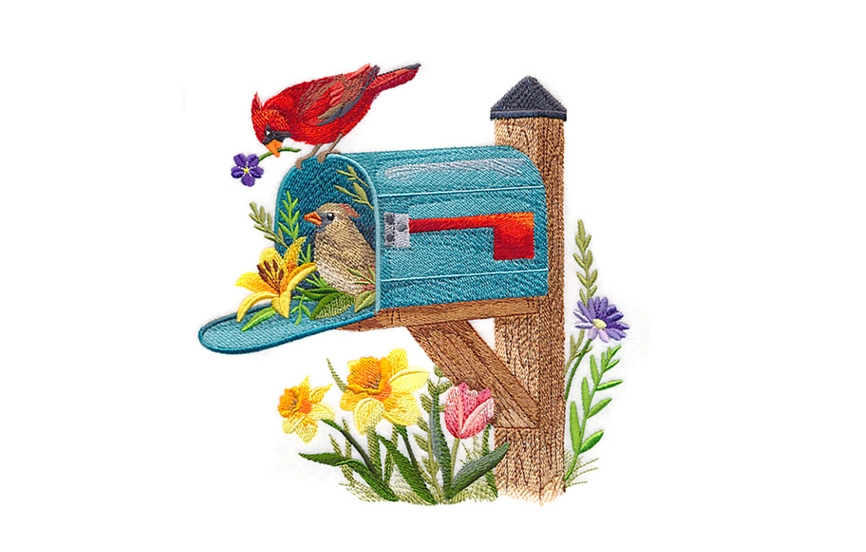When Winnie's Baby-Soft Flannel quilt was featured in the Stitchers Showcase, many embroiderers wrote in, wondering exactly how the quilt was made.
Winnie is kind enough to share her technique and instructions in this Flannel Rag Quilt project. Thank you, Winnie, for being a special guest project instructor and sharing your secrets!
Click here to see more of Winnie's fantastic work from the Stitchers Showcase. And read below for instructions from Winnie for making a flannel rag quilt!
Making rag quilts is something that I really enjoy doing - from choosing the fabric and finding just the right designs for each quilt. Each one is different and created for a special reason, or person. It is fun and a fairly quick project. And rag quilts are very forgiving - anyone can make one!
This rag quilt is made from quilter's flannel and I used flannelette for the batting. I find that the flannelette works really well and gives and adequate weight to the quilt. in Canada, flannelette is a term used to describe inexpensive flannel with a loose weave and nap on just one side. If you are unable to find flannelette in the United States, you can use any type of inexpensive flannel for your batting.
One thing to note is that the flannel will shift and that is normal. It is nothing to panic about. I always say that a rag quilt is not pretty until it is washed and dried. My best advice for creating a rag quilt is to pin it well while constructing it!
A rag quilt can be of any sized blocks. It is just a matter of how big you wish the quilt to be.
Supplies
| Supplies needed: ** 1 1/2 yards of flannel (light green) ** 1 1/2 yards of flannel (dark green) ** 4 1/2 yards of patterned flannel (star) ** 4 yards of flannelette (or any inexpensive flannel) ** Clipping scissors ** Dressmakers pencil ** Air-erase pen |
| Designs Used: ** Twinkle Twinkle Little Star - Large also available in Small ** Twinkle Twinkle Little Star and Moon- Large also available in Small ** I See the Moon - Large also available in Small ** Sandman - Large also available in Small ** Cow in Pajamas - Large also available in Small ** Fairy Claire and Moon - Large also available in Small ** Bedtime Fairy - Large also available in Small ** Sun and Moon Medley - Large also available in Small ** Cow and Moon ** Cow Jumped Over the Moon - Large also available in Small ** Dare to Dream ** Princess Stars - Large also available in Small |
Designs Used
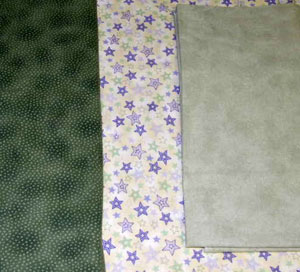
The first thing I do is wash, dry, and iron all the fabric. This is something I strongly recommend. Flannel will shrink and it is best to have as much shrinkage before the design is embroidered. Flannelette will shrink far more than the flannel fabric.
I used only three colors of flannel; one light green, one dark green, and one having a star print. The star print inspired me to go with a moon and stars theme. I searched on the Embroidery Library website to find my all of my designs for this quilt.
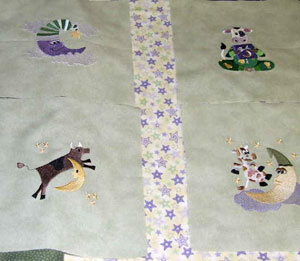
For this quilt, I cut my embroidery blocks to 9 1/2 inches square and then trimmed to 9 inches after the embroidery was done. I made sure that the embroidery is centered.
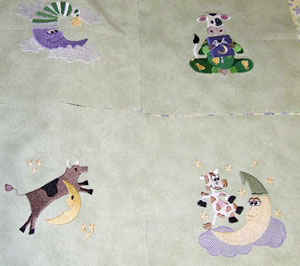
The main part of the quilt had 25 blocks - 13 dark green and 12 light green with embroidery. I cut 25 star fabric blocks at 9 inches square for the back of this quilt.
I also cut 25 blocks of flannelette at 9 inches square for the batting.
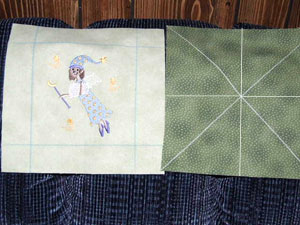
On the dark green blocks, I marked an "X" and then marked two other lines - from top to bottom and then from side to side. (Normally, I would just mark an X, but decided to extra stitching to hold the block together well). I mark the blocks with a dress makers pencil before I make the sandwiches. And on the embroidered blocks, I marked 1 1/2 " in from each side and top and bottom with an air-erase pen.
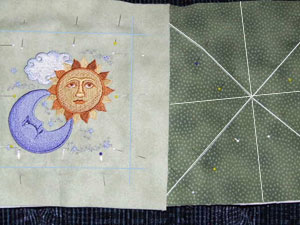
I stitched my "sandwiches" together, which consisted of the top fabric, the flannelette, and the backing fabric. The top and bottom blocks were wrong sides together with a piece of flannelette in the middle.
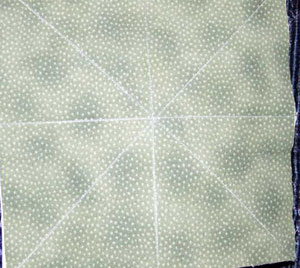
Then I pinned and stitched along the marked lines. I used a quilting needle or denim needle in the sewing machine, and a thread to match my fabric, so it is not really noticeable. I did not use the walking foot when I did the stitching on the blocks. I did some stitching close to each embroidery design to hold the block somewhat in the middle.
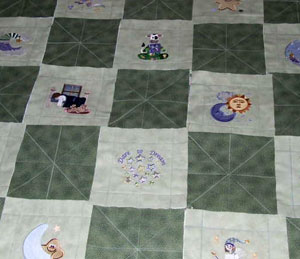
After I had my blocks stitched, I laid them out on the bed to decide how I wanted to arrange the embroidered blocks.

When I was happy with my layout, I copied the order of the designs onto a piece of paper. Then I pinned the blocks in place by rows.
I started with two blocks and aligned the backs of the quilt blocks together. I pinned along the common edges of the blocks through all of the layers.
I repeated this step for all remaining blocks in that row.
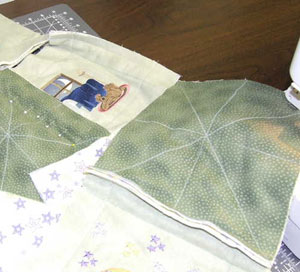
I attached the walking foot onto my machine again, and I used a 1/2 inch guide. I sewed the blocks as pinned, about 1/2 inch from the edge of the block, backstitching at the beginning and every end of every section. I chain sew as much as possible.
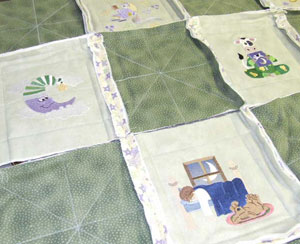
Then I started to pin the rows together. I spread the seams flat on the top and bottom and try to line up the seams, so that when they are when sewn, they are lined up on the back. I made sure bottom seams were open as I sewed. This lessened the bulk of the seams. I again backstitched at each section where the blocks join. I sewed rows 1 and 2. Then I sewed rows 3 and 4, and then sewed row 5 on the bottom.
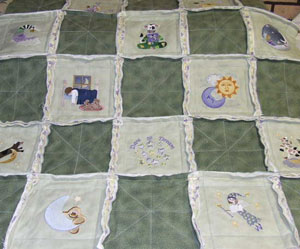
Now all 25 quilt blocks have been sewn together. If this size works for your project, you can just skip to the binding instructions listed below.
I wanted this quilt to be bigger so I added a border of more quilt blocks. I cut my pieces for the border to be 6 1/2 x 9 inches. (I needed 20 top pieces, 20 bottom pieces, and 20 pieces of flannelette for the middle.) The width of the border can be as long as you wish, but the length needs to be the same as the blocks for the main part of the quilt.

I embroidered a star design for all four corners of the quilt, so I cut the squares large and trimmed them to 6 1/2 inches square after the design was embroidered. I also cut four 6 1/2 pieces of star fabric for the back and four 6 /12 pieces of flannelette for the middle. I marked the strips with an X, pinned, and sewed. I did not do any extra stitching on these strips, just an X.
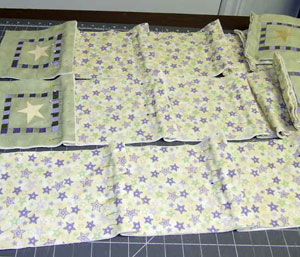
I stitched around the embroidered square and from the corner of the embroidery design out to the edge. When these were done, I pinned the blocks together in rows of 5 blocks. A corner block sewn to each end of two rows. (If your embroidery design is directional, then pin in the right direction.) I could have used the same star fabric for corner block instead of embroidering the star design - it is a matter of personal choice.
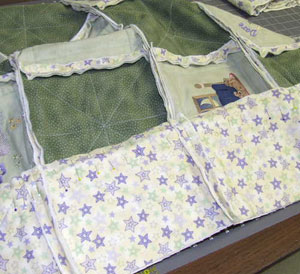
Once the blocks in each row were sewn, I pinned the rows onto the quilt. I pinned one side and sewed it to the main part of the quilt. I pinned the other side and sewed it. I only do one side at a time because the pins are sharp. Then I pinned the top row (with the star blocks on either end) and sewed it to the top row. Next, I pinned the bottom row and sewed that, too.
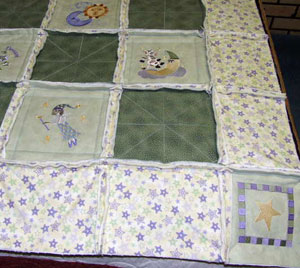
With the quilt completely sewn together, I started on the binding. The quilt measured about 52 inches square, so I created 52 inches of binding for each side.
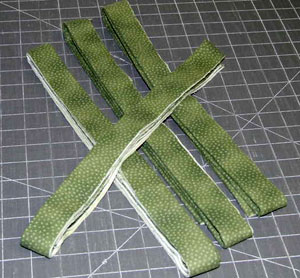
Binding
I cut 12 strips of flannel for the binding. I cut 6 of the light green and 6 of the dark green. Each piece is 2 1/4 inches x about 38 inches. (I cut my strips the width of the flannel fabric. The fabric was about 40 inches before being washed and shrunk to 38 inches.)
Each side of the quilt required 1 1/2 of these strips. I cut two of the strips in half to 2 1/4 x 19 inches long. I sewed a dark green fabric 19 inch strip to the 38 inch dark green fabric strip, which created one long 57 inch strip. I repeated this step for all the dark green strips, and then the light green stitched. I pressed open the seam on all 8 strips.
I ironed a dark green strip and light green strip, wrong sides together. The two pieces of flannel stuck together after being pressed. I made sure the seams on each strip were not in the same place because I did not want the added bulk. I repeated this step until I had 4 strips at 58 inches long with light green on one side and dark green on the other. I then pressed them in half, the length of the strip.
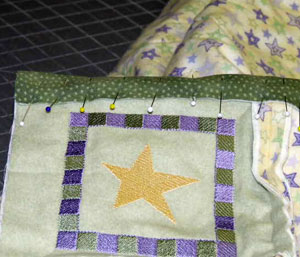
I started at the top corner with a raw end of binding and pinned the entire length of the side. I made sure the binding was wrapped around all the layers.
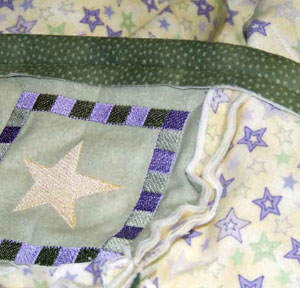
I sewed the binding on the quilt about 5/8 inches from the outside edge. I backstitched at the beginning and end of the binding.

Then I pinned and sewed the binding to the end of the first side. After I sewed the entire side, I clipped off the excess binding, leaving a raw edge.
I then sewed the other side of the binding the same way.
The raw edges of the binding were covered with a finished edge when I sewed the top and bottom binding.
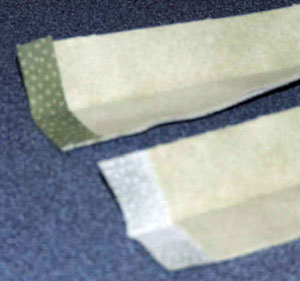
To create the finished edge on the top and bottom binding, I peeled the light green color back from the end of the strip and cut the light green fabric. I then folded the dark green fabric over the end.
I started at the top edge corner with the finished end of the binding.
I pinned a small amount first and then sew out to the end. I did this because there was a lot of bulk and it was hard to start with out pinning the first few inches.
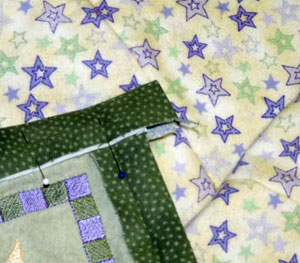
I sewed to the other corner and when I came to the end, I left about a one inch overhang. I again peeled the binding apart and cut the light green flannel underneath. I cut the light green fabric to about 1inch. Then I folded the the dark green flannel over the light green flannel to create a finished corner
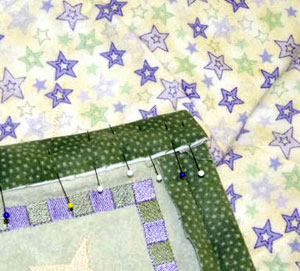
I completed the seam with a backstitch.
I repeated the same steps for the bottom binding.
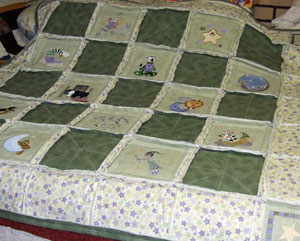
The quilt binding was done and I was ready to clip!
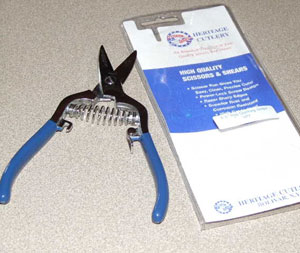
Clipping
I used a Heritage Cutlery Rag Clipping scissors to clip my quilts. They operate on a spring and I think it is the only way to clip. There are other scissors available, but I feel that you need the proper clipping scissors. Be careful not to cut the seams as you clip.
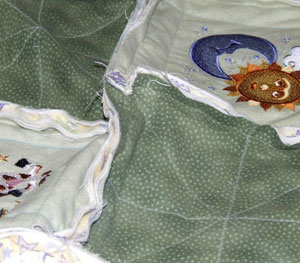
Before I started the major clipping, I went over the whole quilt and clipped all the joining seams.
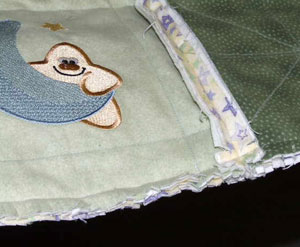
I folded the quilt so the first seam was hanging slightly over the edge of my table. I was only in contact with just the raw edge that I was clipping. I took every precaution not to clip into my quilt - I can not stress this enough.
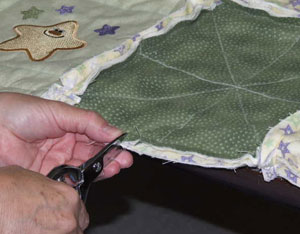
I clipped every 1/4 inch. The more clipping the fluffier the rag and that is what I like. I clipped one row, folded the next row, and clipped again. When the quilt is completely clipped one way, I turned it and clipped all the rows in the opposite direction.

Then I clipped the binding on all four sides, front and back, until the entire quilt was clipped.
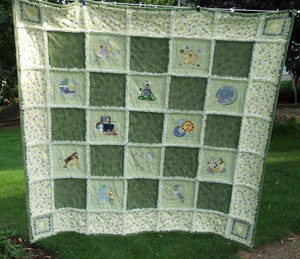
I looked over my quilt and clipped any areas that I missed. Then I took it outside and shook it to remove as many loose fibers as possible.
Then I put the quilt in the washer. After I finished washing the quilt, I ran the washer on the rinse cycle to flush the fibers from the machine.
I dried the quilt in the dryer until it was almost dry, then I took it out and hang it on the line.
While the quilt is on the line, I clipped any long threads and used a sticky roller to remove loose fibers (and there will be many). Some flannels can become a little nubby. If that happens, I use an electric defuzzer on the fabric.
This quilt is a gift for a friend's daughter-in-law who is having a baby soon. It is a gift from the heart.
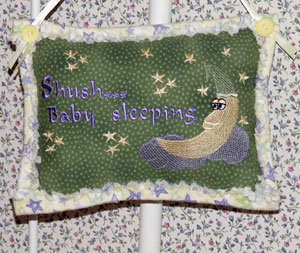
Door Hanger
I also created this matching door hanger for the baby's room. It says "Shush...Baby Sleeping". This simple project can be done at any size, with any design!
I embroidered the design on a 9 1/2 inch square of fabric. I used my embroidery software to isolate just the moon from the Cow and Moon, Welcome design. Then, I used an alphabet to add the statement "Shush...Baby sleeping". Lastly, I embroidered additional stars, which were from the Stars and Swirls (Miniature) design.
After I embroidered all the designs and letters, I trimmed the block to 7 x 8 1/2 inches. I made an envelope back by using two pieces of fabric 8 1/2 x 10 inches and folded each in half and pinned to the front pillow piece (wrong sides together) and stitched a 1/4 inch seam all around the outside. Because the pillow is small, I cut the binding strips about 1 1/2 inch wide and the length needed an attached each piece in the same manner as for the quilt, sewing in a generous 1/4 inch. I made a small pillow insert, stuffed it with batting and inserted the pillow. I used narrow ribbon and buttons to make the hanger.
I carefully used my clippers on the front and back of the pillow on the binding. I did not wash the pillow when it was completed. I just misted the binding and rubbed it a bit with my fingers to give it a rag effect.
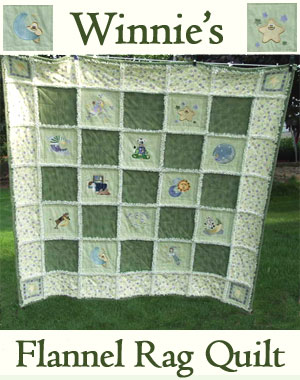
Thanks, Winnie! Your quilt looks amazing and I am sure that your fellow embroiderers can not wait to make one for themselves or as a gift!

